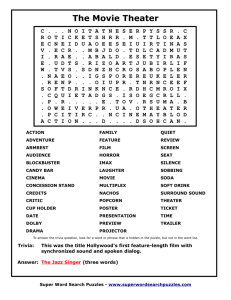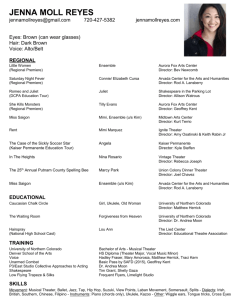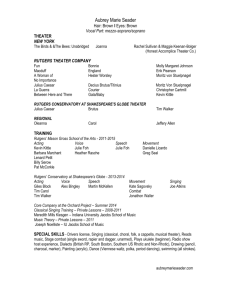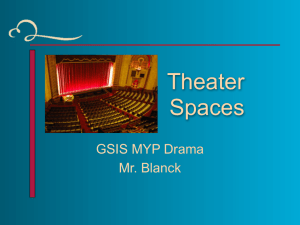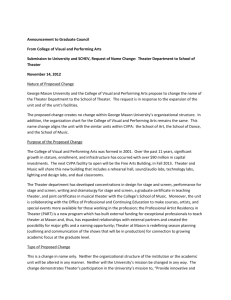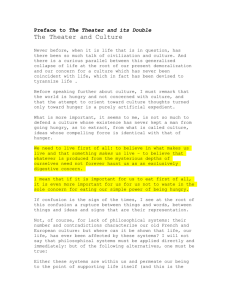movie theater building design objectives
advertisement
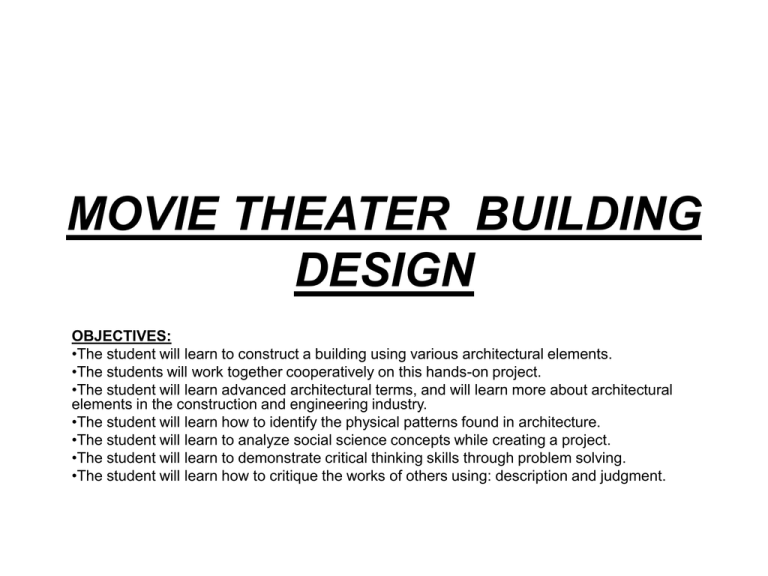
MOVIE THEATER BUILDING DESIGN OBJECTIVES: •The student will learn to construct a building using various architectural elements. •The students will work together cooperatively on this hands-on project. •The student will learn advanced architectural terms, and will learn more about architectural elements in the construction and engineering industry. •The student will learn how to identify the physical patterns found in architecture. •The student will learn to analyze social science concepts while creating a project. •The student will learn to demonstrate critical thinking skills through problem solving. •The student will learn how to critique the works of others using: description and judgment. INTRODUCTION: • Designing a theater can be an exciting, challenging, and rewarding experience. A properly designed cinema can provide a patron with many years of enjoyable and comfortable movies. • Playing the role of an architect allows you, as the developer, to design around your personal needs and desires. How would you as an architect, design your ultimate multiplex and decide where it best belongs on your newly acquired piece of land? VOCABULARY: Using internet sources, define each term. • • • • • • • Multiplex Megaplex Cinema Concession Projection Booth Acoustics Historic • • • • • • • Lighting Atrium Urban Aesthetic Pedestrian Community PROCEDURE: PART ONE • Students will design spaces of their theater. Each space must be diagramed in the forms of circles. • The relationships of each space in close proximity to one another must be established and presented to the teacher. • Each space should be proportional in size comparative to other spaces (the closets and bathrooms should be the smaller circles). PROCEDURE: PART TWO • Transform bubble diagrams to scaled grid paper in preparation of drafting final drawings (see bubble to grid). • Each group will choose a site in which their development will form a community (provided by the teacher). ORAL PRESENTATION: • Each group will present a brief oral presentation on their project demonstrating how they used their creativity in designing a theater while still meeting the minimum criteria. • Refer to evaluation rubric for more information on grading requirements. PROJECT CRITERIA: • Your design must not exceed 25,000 square feet. • Every design must have, but is not limited to, 2 movie rooms (auditoriums that seats 200), four bathrooms, lobby, concession area, waiting area, ticket counter and ticket taker stands, theater style seats, • Floor and elevation plans must be to proper scale of ¼”=1’-0”. • Building must be represented on the site plan provided by teacher. • Oral presentations must describe your design process and finished product. SITE PLAN: • Students will design a building that fits the site plan given. The team must make decisions about where the front access is to the building. • Site planning includes the design of vehicular and pedestrian flows of traffic. Taking advantage of main street access or secondary access (for more privacy) is essential to the placement of the structure. SITE PLAN: LINEAR FLOOR PLAN – Spaces are arranged along a common/main corridor (hallway). CENTRALIZED FLOOR PLAN – Spaces arranged around a central area, usually a courtyard. AXIAL FLOOR PLAN – Spaces arranged along corridors (hallways) from a central area in a radial pattern. COMBINATION FLOOR PLAN SYSTEMS The proposed floor plan submitted for approval must include the following: 1. Booth configuration drawn to scale, including base dimensions, heights and locations. 2. Aisle locations and dimensions must be a minimum of four (4) feet wide. 3. Location and dimensions of all fixtures including, but not limited to, stages risers, registration areas, lounge areas, entertainment areas, etc. 4. Location of all exits. 5. Location of all permanent and temporary concession and novelty stands. 6. Location of all fire safety devices including extinguisher and alarm stations. 7. Location of all primary entrances. 8. Locations and dimensions of all service desks, including space allocations for service desks operated by the theater. 9. Location and dimensions of service contractor storage areas. GRADING CRITERIA: Bubble Diagrams 15% Grid Floor Plans 15% Drawings 15% Class work (Diagrams and Grids) 15% Presentations 15% Warm Ups Assignments 15% Class Participation 5% Quality of work and clean-up 5% Total 100% - 300 points 300 points 300 points 300 points 300 points 300 points 100 points 100 points 2000 points GRADING RUBRICS: • Student’s grades will be calculated by: Quality of lines Precision Accuracy • Level of use for instruments and equipment Functional use Precise of the scale rule Level of neatness • Effective use of time

